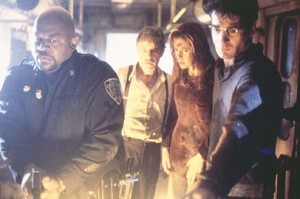In 1997 Guillermo Del Toro begrudgingly released his second feature film, Mimic. Inspired by a short story by Donald A, Wollheim the film was originally developed as a short that would have appeared in an anthology called Light Years. The film, along with an adaptation of Philip K. Dick’s Impostor, were instead picked up as feature length films. During the pre-production process Del Toro watched his original concept for the story, which went through numerous drafts with a variety of writers working with Del Toro, as well as the design of the creatures in the film stray from his original vision. Studio interference continued throughout principle photography and while Del Toro remained in the director’s chair numerous scenes shot by the 2nd unit (which apparently at one point included Robert Rodriguez) took the narrative off in directions that Del Toro disagreed with. Despite his objections these scenes made it into the theatrical release of the film.
Not that I knew any of this when I saw the film on DVD in 1998. At the time Del Toro had yet to establish himself as one of my favorite directors. I doubt I even made the connection between Cronos and Mimic until sometime after Blade 2. No, I bought Mimic based on my love for sci-fi horror films and Mira Sorvino.
Mimic offered more than the B-movie thrills I was expecting. It’s atmosphere was pervasive and brooding, the character design was brilliant and while the ending seemed a bit too rosy the script was far more intelligent than a traditional genre film, particularly on about giant cockroaches.
In Del Toro’s new director’s cut the story of the film remains pretty much the same. When a disease spread by cockroaches threatens to kill off the children of Manhattan Entomologist Susan Tyler (Sorvino) genetically engineers an insect called the Judas Breed to wipe out the cockroach population. The Judas Breed works famously but rather than dying off after one generation the insect continues to breed in the sewers of New York City. Just three years after their creation the Judas Breed have evolved in to an unimaginable threat.
What has changed is the subtext. The theatrical cut of Mimic never touched upon the philosophic and spiritual aspects of why the insects survived and evolved. The director’s cut reinstates scenes that hint at Del Toro’s original ideas that became more and more watered down with each revision of the script.
The new cut also removes all but one of the scenes shot by the 2nd unit. The purpose of many of the exorcised scenes was to over explain aspects of the film that the producers thought audiences were too dumb to pick up on. The fact that the scenes can be removed entirely and not take away from the understanding of the film’s narrative speaks volumes.
Unlike many of the Miramax titles that are being released by Lionsgate, Mimic features new extras including a video prologue, an excellent featurette “Reclaiming Mimic” and an interesting audio commentary from Del Toro that not only talks about the making of the film, the various changes from the original storyline but also his approach to filmmaking and how Mimic forever changed the way he approached projects. Also included are featurettes on the creature design and shooting of the film as well as deleted scenes, storyboard animatics, a gag reel and the theatrical trailer.
On the surface Guillermo Del Toro’s director’s cut isn’t dramatically different from the theatrical version in that the story remains intact but the new cut is a better and more intelligent. It’s a shame that we’ll never get to see the film end in the way that Del Toro originally intended. That would have been something special. As it stands Mimic is still an excellent film that belongs in your Blu-ray collection.
